With a more extended listening session today, I have a more defined opinion of the Harsch filter.
I evaluated the 200 Hz and the 2 kHz filters separately, and also together.
The 2 kHz showed almost no difference on-axis between the LR4 and the Harsch. I made a single horizontal 45 degree off axis measurement, and there was not much difference, but the LR4 seemed slightly smoother. I did not make any vertical off-axis measurements.
Listening to the difference between the Harsch and LR4 at 2 kHz, I honestly could barely detect any difference. I listened to both the satellites by themselves, and with the woofer cabinets (I have a filter which allows the 6 inch mid driver to run full range down to 60 Hz). I was hoping to hear an improvement in imaging due to the transient perfect performance of the Harsch, but I did not.
The 200 Hz required some work to get right. I could not get a good step response, and I realized I needed to refine the delay on the mid driver. I started back to square one, and re-did the driver measurements. Somehow I must have measured something wrong back in April, I needed an additional 9 inches of delay for the phase of the mid and the woofer to be aligned. This error would obviously affect both the Harsch and the LR4 filter.
Once I corrected the delay problem, the LR4 filter sounded improved compared to the old LR4. There was more clarity in the upper bass, less congestion. The improvement to the Harsch was less... it sounded good before, and it still sounded good. For whatever reason, it did not seem as affected by the 9 inches change in delay.
Comparing the Harsch to the LR4 (both with the correct delay, using Harsch or LR4 at both 200 and 2000 Hz), I still prefer the LR4. The Harsch measured better in area near the 200 Hz crossover, but it seemed like there was too much energy there... a chestiness or boxiness. It is possible that the Harsch filter needs to be optimized to get a fair comparison. After all, I have been optimizing the LR4 filters for months.
I will post a plot when I get to my other computer in a few minutes.
I evaluated the 200 Hz and the 2 kHz filters separately, and also together.
The 2 kHz showed almost no difference on-axis between the LR4 and the Harsch. I made a single horizontal 45 degree off axis measurement, and there was not much difference, but the LR4 seemed slightly smoother. I did not make any vertical off-axis measurements.
Listening to the difference between the Harsch and LR4 at 2 kHz, I honestly could barely detect any difference. I listened to both the satellites by themselves, and with the woofer cabinets (I have a filter which allows the 6 inch mid driver to run full range down to 60 Hz). I was hoping to hear an improvement in imaging due to the transient perfect performance of the Harsch, but I did not.
The 200 Hz required some work to get right. I could not get a good step response, and I realized I needed to refine the delay on the mid driver. I started back to square one, and re-did the driver measurements. Somehow I must have measured something wrong back in April, I needed an additional 9 inches of delay for the phase of the mid and the woofer to be aligned. This error would obviously affect both the Harsch and the LR4 filter.
Once I corrected the delay problem, the LR4 filter sounded improved compared to the old LR4. There was more clarity in the upper bass, less congestion. The improvement to the Harsch was less... it sounded good before, and it still sounded good. For whatever reason, it did not seem as affected by the 9 inches change in delay.
Comparing the Harsch to the LR4 (both with the correct delay, using Harsch or LR4 at both 200 and 2000 Hz), I still prefer the LR4. The Harsch measured better in area near the 200 Hz crossover, but it seemed like there was too much energy there... a chestiness or boxiness. It is possible that the Harsch filter needs to be optimized to get a fair comparison. After all, I have been optimizing the LR4 filters for months.
I will post a plot when I get to my other computer in a few minutes.
Well crud... I did not save the FRD file from the full-up Harsch filter network... and I have already put away all of my test gear.
Well anyway, here is a plot of the LR4 filters with the wrong delay (black) and the new correct delay (red).
If I recall, the Harsch filter looked very similar to these from 500 Hz up. In the 200 Hz region, it was almost flat, which would seem to be an improvement, but I found it too heavy in the upper bass / lower midrange on most recordings. As I said before, it deserves a process of optimization before I pass judgment on it.
YSDR - you suggested I try LR2 on my lower crossover. I have tried it several times, and with other drivers and cabinets, it is probably an improvement. My woofer does not like to go above 500 Hz. It needs the steep 24 dB/octave cut.
Well anyway, here is a plot of the LR4 filters with the wrong delay (black) and the new correct delay (red).
If I recall, the Harsch filter looked very similar to these from 500 Hz up. In the 200 Hz region, it was almost flat, which would seem to be an improvement, but I found it too heavy in the upper bass / lower midrange on most recordings. As I said before, it deserves a process of optimization before I pass judgment on it.
YSDR - you suggested I try LR2 on my lower crossover. I have tried it several times, and with other drivers and cabinets, it is probably an improvement. My woofer does not like to go above 500 Hz. It needs the steep 24 dB/octave cut.
Attachments
These are my findings too. I tried both Harsch and FIR many times on many different systems - but could only detect a real difference when using FIR on a set of Quad electrostats... but they have their own problems.Listening to the difference between the Harsch and LR4 at 2 kHz, I honestly could barely detect any difference. I listened to both the satellites by themselves, and with the woofer cabinets (I have a filter which allows the 6 inch mid driver to run full range down to 60 Hz). I was hoping to hear an improvement in imaging due to the transient perfect performance of the Harsch, but I did not.
.
What I really find to be a big issue - everytime - is FR. If there is some bump or dip somewhere, then it might not always be heard - but if somethings sounds wrong, mostly there is an uneveness in the FR or timing problem.
I looked at phase many time - but only found/heard problems when it was related to timing between midrange and tweeter.
I use LR4 on a set of 3 ways with 4 subwoofers - with near flat and smooth FR - also off axis. Then I dont feel the need to worry about phase
It seems you guys all prefer LR4 over Harsch - and that’s ok. It’s most noticeable to me on recordings of smaller ensembles that are minimally post processed. Live jazz in a club, and stuff with drums, stand up bass, guitar, piano. Percussive snaps, plucks, and sharp edged sounds like a rim shot are more realistic. Placement of the band members are more realistic. It’s the same reason why some people like the imaging and realism of single driver fullrange. It’s not going to matter as much with rock, pop, classical symphonic recordings.
Like I said, I think I would need to spend more time dialing in the Harsch before I could make a truly fair assessment.
I think some people are more sensitive to certain aspects of phase such that they prefer a transient perfect speaker. the long term popularity of Vandersteen and Theil speakers attests to that. I am not one of those people. When I listen to a Vandersteen or Theil, I hear a great sounding speaker, but not one that stands out from other equally good speakers with high order networks.
I believe I am more sensitive than most people to small aberrations in frequency response, more sensitive to odd-order harmonic distortion, and more sensitive to low frequency group delay.
So I may not be the right person to judge the Harsch crossover, even after I dial it in...
For my subjective evaluation, I used my current go-to set of recordings:
Jazz at Lincoln Center, Winton Marsalis "Handful of Keys", 24 bit 96 kHz FLAC.
Joey Alexander "Eclipse", 24 bit 96 kHz FLAC.
Trio Celeste "Beethoven and Dvorak Piano Trios" 24 bit 96 kHz FLAC.
I highly recommend all three recordings. The performances are deeply satisfying, and whoever recorded and mastered them deserves to be recognized...
I think some people are more sensitive to certain aspects of phase such that they prefer a transient perfect speaker. the long term popularity of Vandersteen and Theil speakers attests to that. I am not one of those people. When I listen to a Vandersteen or Theil, I hear a great sounding speaker, but not one that stands out from other equally good speakers with high order networks.
I believe I am more sensitive than most people to small aberrations in frequency response, more sensitive to odd-order harmonic distortion, and more sensitive to low frequency group delay.
So I may not be the right person to judge the Harsch crossover, even after I dial it in...
For my subjective evaluation, I used my current go-to set of recordings:
Jazz at Lincoln Center, Winton Marsalis "Handful of Keys", 24 bit 96 kHz FLAC.
Joey Alexander "Eclipse", 24 bit 96 kHz FLAC.
Trio Celeste "Beethoven and Dvorak Piano Trios" 24 bit 96 kHz FLAC.
I highly recommend all three recordings. The performances are deeply satisfying, and whoever recorded and mastered them deserves to be recognized...
Thanks for the test track recommendations, Jim! I will check them out.
Btw, did you see this new possible simple passive Harsch XO with a RAAL 70-20xr and PTT6.5? Needs 2in setback on the tweeter - or a 2in deep waveguide. Not as difficult on a ribbon as there is very little vertical dispersion so won’t have as much an issue with a reflection from the bottom step of a piece of foam is placed there.
RAAL 70-20xr and PTT6.5 Compact TL
This is purely simulation at this point, but the sim is darn accurate based on earlier XO1 I made and verified.
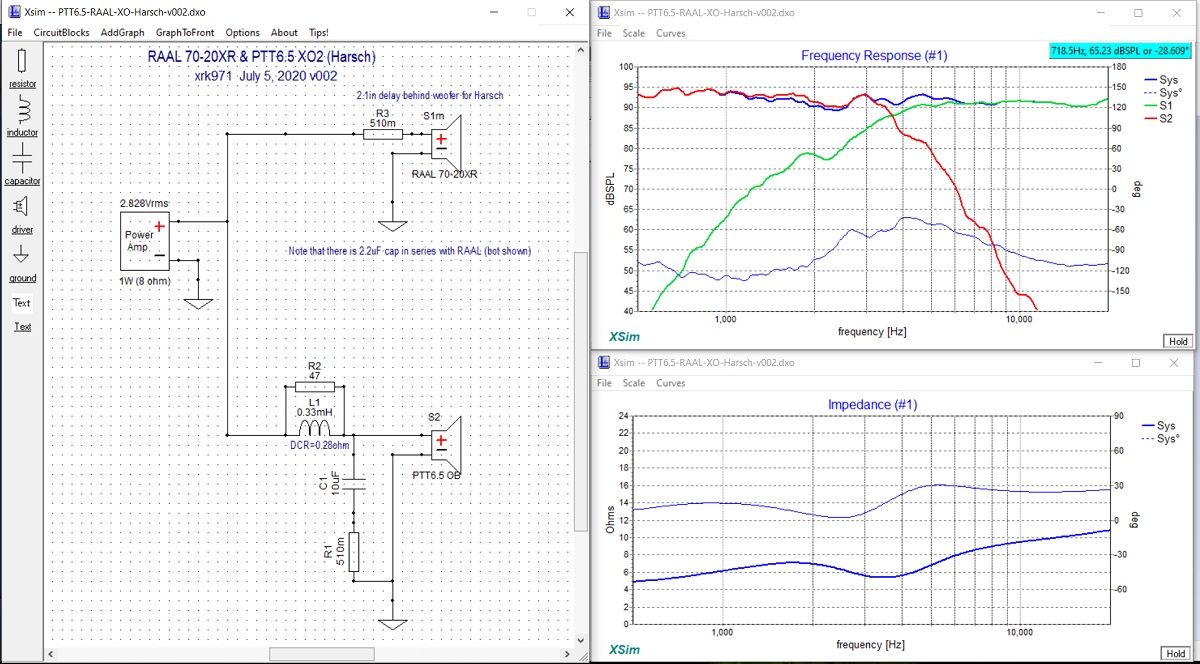
The dip and peak at 2.2kHz and 2.8kHz of circa 4dB peak to peak may be a problem for some though. It might be related to the sharp edge baffle of the open baffle test fixture. A real box with a round over edge may smooth that out some. Real TL box is getting re-made due to internal TL channel air leak. So waiting for about 2 weeks I think.
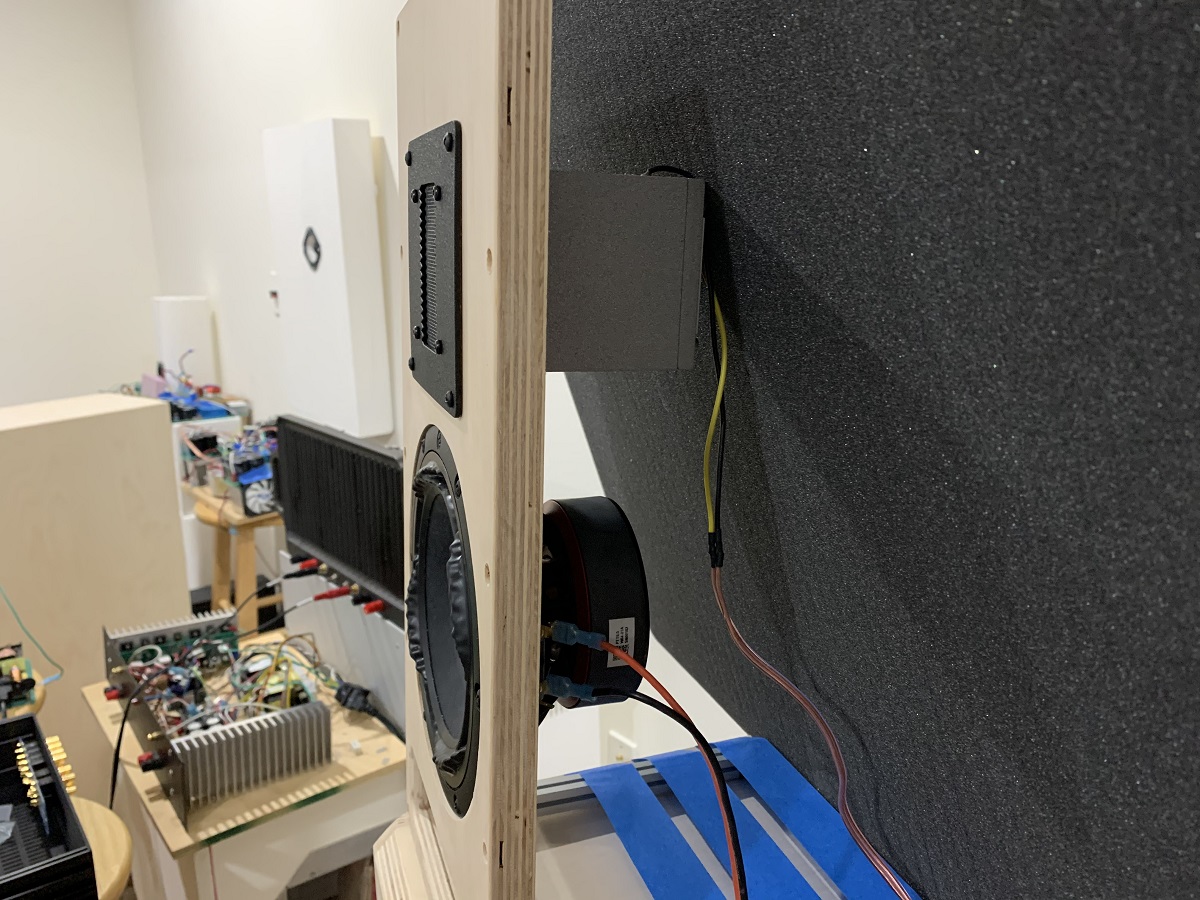
Btw, did you see this new possible simple passive Harsch XO with a RAAL 70-20xr and PTT6.5? Needs 2in setback on the tweeter - or a 2in deep waveguide. Not as difficult on a ribbon as there is very little vertical dispersion so won’t have as much an issue with a reflection from the bottom step of a piece of foam is placed there.
RAAL 70-20xr and PTT6.5 Compact TL
This is purely simulation at this point, but the sim is darn accurate based on earlier XO1 I made and verified.
The dip and peak at 2.2kHz and 2.8kHz of circa 4dB peak to peak may be a problem for some though. It might be related to the sharp edge baffle of the open baffle test fixture. A real box with a round over edge may smooth that out some. Real TL box is getting re-made due to internal TL channel air leak. So waiting for about 2 weeks I think.
Last edited:
I would really like it to work, cause I like the idea. But like you point out - it also really matters what you listen to. Even though my phase is all over the place with my LR4 filters and EQ - then I still sense a very clean phantom center when I listen to an interview on youtube or watch a movie. I'm also very sensitive to FR variations - but will keep experimenting - cause it is a very interesting subjectIt seems you guys all prefer LR4 over Harsch - and that’s ok. It’s most noticeable to me on recordings of smaller ensembles that are minimally post processed.
Hi, I tried to make some experiments in VituixCad. Attached are simulation plots from a three way speaker prototype 15", 8" and a horn. Crossover is DSP IIR filters.
I tried to make as good xover as I could (power response, polars etc. all windows pretty) and then turn it into a Harshish xo. Basically took the XRK quide how to make a Harsh xo and then tweaked a bit with the delays and filter components to get good compromise between system phase, power response and vertical polar map. Horizontal polars seemed to be ok so didn't bother to attach that.
note. I haven't listened the harsh filter shown here yet, so no comments.
To me it seems that with harsh xo one can get pretty good results, but the vertical polars are a bit lobsided, null around xo is pretty close to 0 axis (tweeter axis in this case) comparing to the other simulation which is a lot more symmetric and has wider vertical listening window at the mid - tweet xo. Looks like it would be better to put the tweeter below the woofer with the Harsh xo (null below the listening axis instead of above). Another thing is that I'm not sure it is possible to optimize the power response and listening axis response with this setup but they aren't too wild so I think very usable. Phase doesn't wrap like it does with the other plan.
btw. I could make the phase pretty flat for the woofer - mid xo with many different filter slopes + delay, or without delay by inverting the polarity. I don't know excalty what are the acoustic slopes with either setup Have fun!
Have fun!
ps. the harshish xo was made pretty quickly while the other one is iteration number xxx
pps. noticed the harhs xo doesn't have "global" high pass at 30hz as the other one has, so the groupdelay rises quite a bit less.
I tried to make as good xover as I could (power response, polars etc. all windows pretty) and then turn it into a Harshish xo. Basically took the XRK quide how to make a Harsh xo and then tweaked a bit with the delays and filter components to get good compromise between system phase, power response and vertical polar map. Horizontal polars seemed to be ok so didn't bother to attach that.
note. I haven't listened the harsh filter shown here yet, so no comments.
To me it seems that with harsh xo one can get pretty good results, but the vertical polars are a bit lobsided, null around xo is pretty close to 0 axis (tweeter axis in this case) comparing to the other simulation which is a lot more symmetric and has wider vertical listening window at the mid - tweet xo. Looks like it would be better to put the tweeter below the woofer with the Harsh xo (null below the listening axis instead of above). Another thing is that I'm not sure it is possible to optimize the power response and listening axis response with this setup but they aren't too wild so I think very usable. Phase doesn't wrap like it does with the other plan.
btw. I could make the phase pretty flat for the woofer - mid xo with many different filter slopes + delay, or without delay by inverting the polarity. I don't know excalty what are the acoustic slopes with either setup
ps. the harshish xo was made pretty quickly while the other one is iteration number xxx
pps. noticed the harhs xo doesn't have "global" high pass at 30hz as the other one has, so the groupdelay rises quite a bit less.
Attachments
Last edited:
One more, this is the above xover again. All drivers flipped to positive polarity and then timedelays adjusted so that normal phase is within about 60 degrees. Didn't mind Harsch xo rules and managed to get somewhere in the ballpark.
Edit, another one attached, normal phase within 30deg just by adjusting delays in a pretty good crossover.
Edit, acoustic filters slopes seem to be close to 3rd order bessel for high passes, mid lowpass is close to 3rd order butterworth, woofer lowpass is close to 2nd order butterworth and other slopes on the woofer lowpass seem to work as well when delay is adjusted.
Edit, another one attached, normal phase within 30deg just by adjusting delays in a pretty good crossover.
Edit, acoustic filters slopes seem to be close to 3rd order bessel for high passes, mid lowpass is close to 3rd order butterworth, woofer lowpass is close to 2nd order butterworth and other slopes on the woofer lowpass seem to work as well when delay is adjusted.
Attachments
Last edited:
One more for completeness sake  same system but with LR4 acoustic slopes. Group delay is a bit worse, all drivers with same polarity, step response gets more wavy.
same system but with LR4 acoustic slopes. Group delay is a bit worse, all drivers with same polarity, step response gets more wavy.
Attachments
Last edited:
Nice work Tmuikkku! It’s tricky getting a 3-way Harsch to work! I have also noticed that the slopes don’t have to be textbook perfect - just close. However, whatever I did lately with the passive Harsch XO using the PTT6.5 and the RS28F in a waveguide seemed to provide a better “right triangle” shape than I ever got from the time I used to do DSP IIR filters. Those all looked like a “bread loaf with a spike” sort of like what you are seeing.
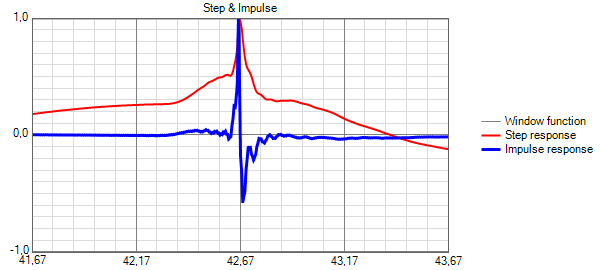
What I see now more closely resembles the step response from a first order XO:
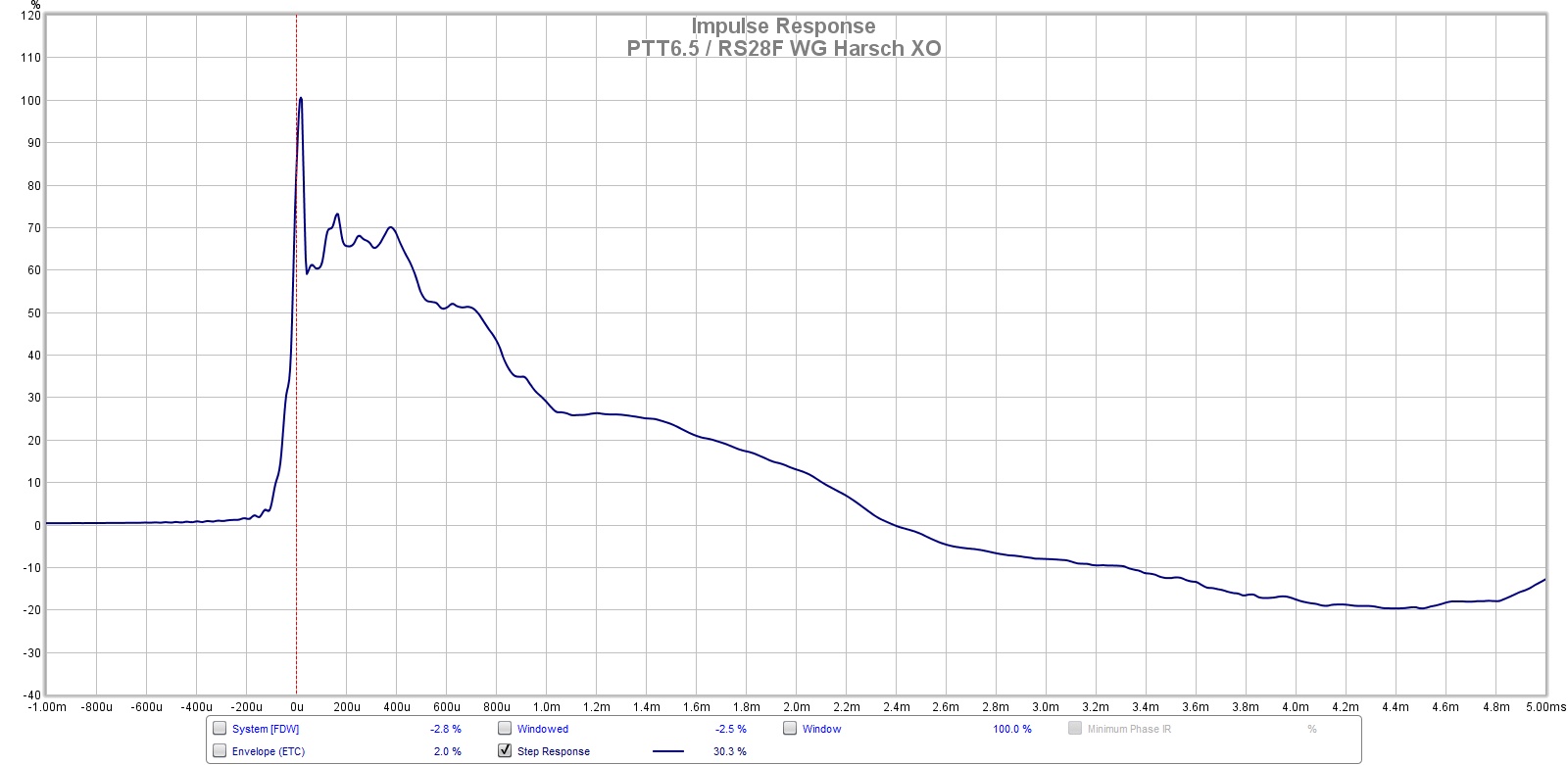
When the step response looks like this, it is a definite improvement in percussive timing clarity and resolution vs the step from an LR4:
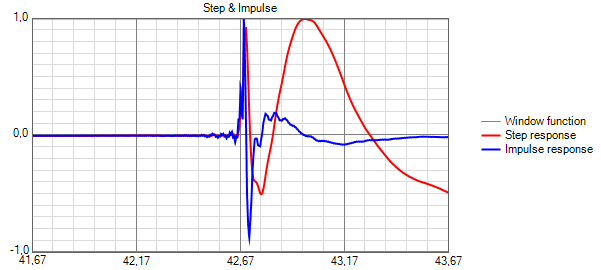
But some people are not as sensitive to this as they are to the little wiggle in frequency response.
Your observation that placing the tweeter below the woofer is a good one and I am already doing that:
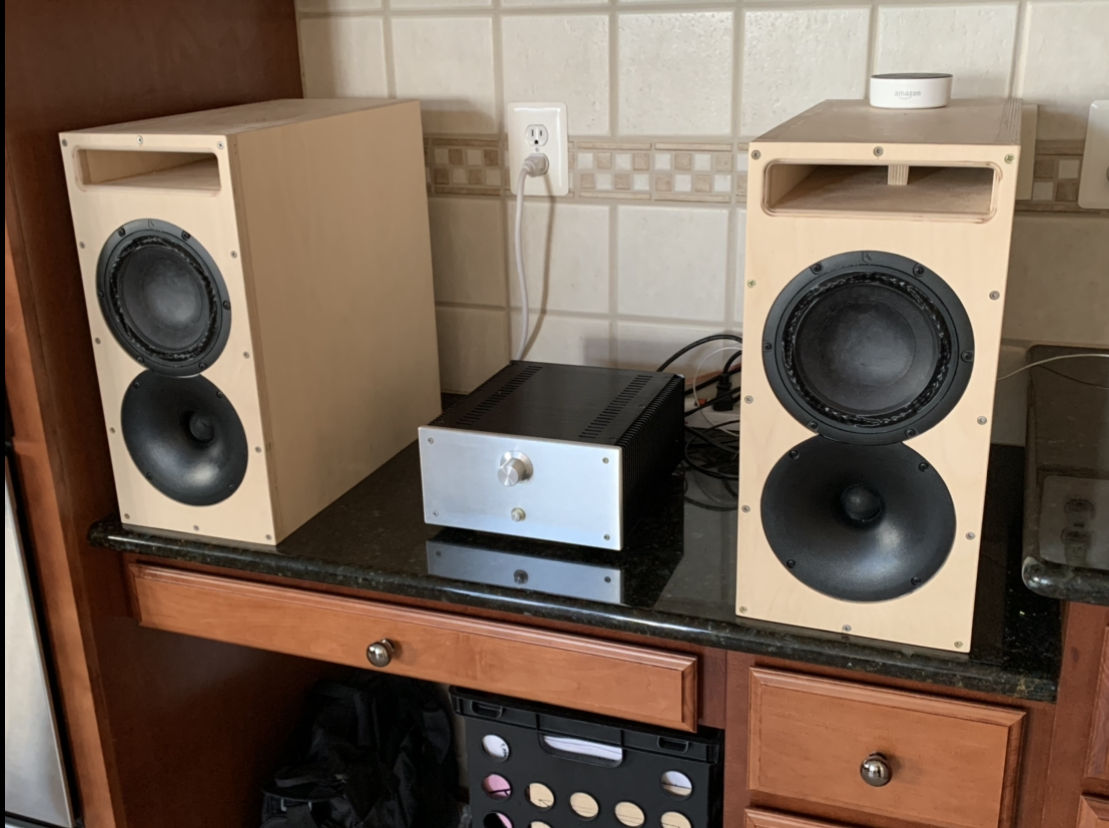
What I see now more closely resembles the step response from a first order XO:
When the step response looks like this, it is a definite improvement in percussive timing clarity and resolution vs the step from an LR4:
But some people are not as sensitive to this as they are to the little wiggle in frequency response.
Your observation that placing the tweeter below the woofer is a good one and I am already doing that:
@xrk
I think if you model this passive Harsch xo with an IIR DSP crossover, you would get exactly the same responses as with the passive version. The problematic part is the modeling, to get exactly the same individual slopes.
With DSP, it's more easy to get textbook slopes, but textbook slopes seems results in a “bread loaf with a spike” step response and your custom slopes resulted a right-side-like triangle step response.
You need to add a name to your custom slopes (e.g. XRK2, XRK4 etc.) and define these new alignments.
I think if you model this passive Harsch xo with an IIR DSP crossover, you would get exactly the same responses as with the passive version. The problematic part is the modeling, to get exactly the same individual slopes.
With DSP, it's more easy to get textbook slopes, but textbook slopes seems results in a “bread loaf with a spike” step response and your custom slopes resulted a right-side-like triangle step response.
You need to add a name to your custom slopes (e.g. XRK2, XRK4 etc.) and define these new alignments.
Last edited:
@xrk
I think if you model this passive Harsch xo with an IIR DSP crossover, you would get exactly the same responses as with the passive version. The problematic part is the modeling, to get exactly the same individual slopes.
With DSP, it's more easy to get textbook slopes, but textbook slopes seems results in a “bread loaf with a spike” step response and your custom slopes resulted a right-side-like triangle step response.
You need to add a name to your custom slopes (e.g. XRK2, XRK4 etc.) and define these new alignments.
Good observations YSDR.
As luck would have it, i was measuring Harsh via IIR DSP this morning, and found xover frequency has a rather large effect on step shape.
Below are 1kHz and 100Hz, where both output channels are summed back together.
Attachments
the more I used delay (advance on the woofer relative to mid and tweeter) the more there was stuff on the left in the step response. I'd quess harsh xo trick works better with a two way setup than threeway since less delay is needed.
Mark100, does this harsh xo go well with your MEH? is there delay between woofer (taps) and tweeter so that no electrical delay is needed? Just came to my mind that MEHs have tweeters behind woofers so there might be some relation in this xo setup?
Mark100, does this harsh xo go well with your MEH? is there delay between woofer (taps) and tweeter so that no electrical delay is needed? Just came to my mind that MEHs have tweeters behind woofers so there might be some relation in this xo setup?
Last edited:
Good observations YSDR.
As luck would have it, i was measuring Harsh via IIR DSP this morning, and found xover frequency has a rather large effect on step shape.
Below are 1kHz and 100Hz, where both output channels are summed back together.
Interesting - my XO is 3500Hz and looks more like your 100Hz one. Maybe I did find a new XO filter slope?
just wondering for my 4 way delay. when i put calculated delay for my midrange, should i combine it with midbass delay with woofer or i just calculate separate delay for midrange? this is also the case for tweeter, whether to add midbass+midrange delay to tweeter or just calculate delay based on tweeter cutoff freq
@gadut
Depends on what type of multiway Harsch xo you want to use. If yo use BW4 slopes for all low-passes and BES2 slopes for all high-passes, then the starting point would be your lowest frequency driver and the next driver in frequency needs timing adjustment to that driver and so on to the rest.
woofer -> time adjusted midwoofer to woofer -> time adjusted midrange to midwoofer -> time adjusted tweeter to midrange
Depends on what type of multiway Harsch xo you want to use. If yo use BW4 slopes for all low-passes and BES2 slopes for all high-passes, then the starting point would be your lowest frequency driver and the next driver in frequency needs timing adjustment to that driver and so on to the rest.
woofer -> time adjusted midwoofer to woofer -> time adjusted midrange to midwoofer -> time adjusted tweeter to midrange
Synergy horns have a minimum phase solution in their original form, unless your MEH is something different.Just came to my mind that MEHs have tweeters behind woofers so there might be some relation in this xo setup?
- Home
- Loudspeakers
- Multi-Way
- S. Harsch XO












